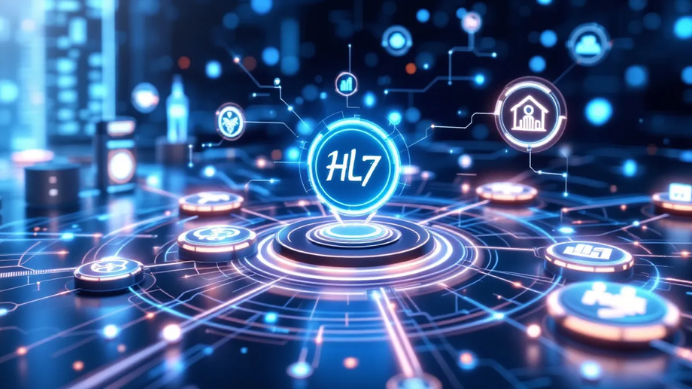
What is HL7 integration? – Best practices
HL7 integration is essential for enabling seamless communication and data exchange across healthcare systems. By standardizing the way medical information is shared, it ensures that healthcare providers can access accurate and timely data, leading to better patient care.
In HL7 hospital integration, the use of HL7 integration tools and HL7 integration engines plays a crucial role in facilitating these processes. These tools and engines streamline the integration process, enabling healthcare organizations to efficiently manage and exchange electronic health records and other vital patient information across different systems.
What is HL7 integration?
HL7 integration refers to the process of connecting healthcare systems, applications, and devices using Health Level Seven (HL7) standards to enable seamless exchange of electronic health information. Developed by Health Level Seven International, HL7 standards provides a framework for managing, exchanging, and retrieving clinical data across disparate healthcare systems.
Its primary objective is to provide a universal language for secure medical data sharing, ensuring that data is exchanged accurately and efficiently. At its core, HL7 integration promotes interoperability in healthcare data sharing, ensuring precision and clarity in every data exchange. This is achieved through a set of standards that dictate how sensitive medical information is collected, processed, and exchanged.
Healthcare institutions, including hospitals, clinics, and labs, implement HL7 integration to enhance data exchange and patient outcomes. Adopting HL7 standards allows these institutions to communicate more effectively, reducing errors and inefficiencies in healthcare processes.
As the healthcare industry continues to evolve, the need for effective data exchange and interpretation across diverse systems will only grow, making HL7 integration more vital than ever.
Components of HL7 Integration
Some of the components of HL7 integration include the following
1. Data standardization
- Purpose: Ensures that data from various sources (e.g., EHRs, laboratory systems) is normalized to conform to HL7 standards.
- Process: Involves mapping data elements like patient demographics and clinical observations to standardized formats, reducing errors and enhancing interoperability.
2. Messaging framework
- HL7 v2: Uses structured messages segmented into fields and segments (e.g., patient identification, clinical orders) for accurate parsing by receiving systems.
- HL7 v3: Employs a model-driven approach for enhanced semantic consistency across messages.
3. HL7 integration engine
- Function: Acts as a central hub for connecting multiple healthcare systems, routing HL7 messages, validating shared messages, and transforming them as needed.
- Examples: Iguana, Definitive Healthcare, NexHealth, Redox, Qvera Interface Engine (QIE)
Benefits of HL7 integration for healthcare providers
HL7 integration offers numerous benefits for healthcare providers, from reducing administrative costs to improving clinical decision-making.
1. Improved interoperability
Integration engines centralize data exchange, allowing multiple systems to communicate through a single interface. This centralization simplifies the process of data transformation and routing, improving interoperability among healthcare systems. Standardizing data formats ensures diverse healthcare systems can communicate effectively, streamlining operations.
2. Enhanced patient care
HL7 integration provides real-time access to patient data, significantly improving care coordination among providers. Timely access to vital patient data through HL7 integration enhances overall decision-making in healthcare. Clinical Decision Support Systems (CDSS) leverage comprehensive patient data for real-time recommendations, further improving patient outcomes.
Seamless data sharing during transfers between medical facilities improves care coordination. Integrating pharmacy systems with electronic medical records systems enhances communication between various healthcare providers and pharmacists.
Additionally, HL7 integration reduces administrative data workloads and enhances patient satisfaction by minimizing wait times and improving access to clinical and administrative data and diagnostic data.
3. Operational efficiency
Facilitating real-time data sharing and communication, HL7 integration streamlines clinical workflows. HL7 standards automate routine tasks, leading to enhanced productivity and more efficient workflows in healthcare settings. Standardized HL7-compliant workflows reduce time spent on manual data entry and exchanges, decreasing the likelihood of errors.
Automation of lab result delivery via HL7 integration reduces manual errors and speeds up diagnostics, contributing to better patient outcomes. Effective medication management through HL7 integration streamlines operations, simplifying the prescription refill process and improving overall operational efficiency.
Use cases of HL7 integration
The use cases of HL7 integration are
1. Electronic health records management
HL7 integration significantly improves EHR management, ensuring better access to and accuracy of patient data. HL7 standards enable real-time updates to EHR systems, providing clinicians with the latest patient information. This capability is essential for making informed clinical decisions and delivering high-quality patient care.
The model outlines the functional requirements necessary for EHR systems. It is designed to support patient care, administrative processes, and security needs. Solutions like those provided by Folio3 Digital Health facilitate efficient data exchange and interoperability among healthcare providers, enhancing the overall electronic medical record management process.
2. Laboratory information systems communication
HL7 integration enhances Laboratory Information Systems (LIS) through automated data exchange processes. This automation reduces turnaround times for lab results, allowing quicker diagnosis and treatment decisions. By streamlining the delivery of lab results, HL7 integration improves operational efficiency and workflow in labs.
Timely and accurate laboratory clinical data exchange among healthcare providers fosters better care coordination. This seamless communication ensures that all relevant data is available when needed, supporting better patient outcomes and more efficient healthcare processes, particularly in the realm of global health data interoperability.
3. Radiology information systems integration
HL7 protocols play a crucial role in the integration of Radiology Information Systems (RIS) with other healthcare systems. This integration enables the automated transfer of imaging orders and results between RIS and EHR systems, ensuring that radiology data is readily accessible to clinicians.
Facilitating seamless communication between RIS and other healthcare systems, HL7 integration enhances imaging processes and overall patient management. This integration supports better diagnostic accuracy and more coordinated care, ultimately leading to improved patient outcomes.
Common challenges in HL7 integration
Some of the challenges in HL7 integration include the following
1. Variability
Diverse interpretations of HL7 standards can result in significant variations in how healthcare data is shared and utilized. Differences in HL7 implementations result in inconsistent data exchange, incomplete records, and vendor lock-in. Numerous healthcare organizations use legacy systems, which were not designed for modern HL7 standards, making integration efforts more complicated.
Unique workflows, data structures, and reporting needs may lead to compatibility issues during HL7 implementation. Excessive standardization may not fully meet an organization’s needs, while over-customization can increase maintenance costs and complicate system upgrades.
2. Data privacy and security compliance
Compliance with regulations like HIPAA and GDPR is essential to safeguard sensitive health information during HL7 integration. Data privacy and security are crucial to protect sensitive healthcare information from breaches, unauthorized access, and data tampering.
Organizations must ensure compliance with these regulations to protect data privacy and avoid severe penalties and loss of trust.
3. Managing various HL7 versions
Managing different HL7 versions presents challenges due to each version’s unique structure and semantics. HL7 Version 3, based on XML, enhances semantic interoperability but is not compatible with earlier versions, posing integration hurdles. Migrating from older to newer HL7 versions requires substantial effort involving complex mapping and translation processes.
Best practices for successful HL7 integration
Some of the best practices for successful HL7 integration include the following
1. Develop a clear strategy
Clearly defined goals and scope are crucial for setting realistic objectives and timelines. Identifying specific interfaces based on healthcare system needs is crucial when planning HL7 integration. Documentation should cover system configurations, troubleshooting guides, and security protocols for effective implementation.
Forming an integration team or partnering with a vendor helps establish a comprehensive integration strategy. This team can provide the necessary expertise and support for successful HL7 integration, ensuring that all aspects of the process are thoroughly planned and executed.
2. Conduct rigorous training
Rigorous testing verifies data exchanges and processes, identifying potential issues before they disrupt workflows. Necessary testing types for HL7 integration include unit testing, integration testing, and full-scale system testing. Continuous monitoring is necessary post-integration to adapt to evolving healthcare IT demands and maintain system efficacy.
Monitoring real-time data exchanges post-deployment ensures ongoing accuracy and reliability. Pilot runs with limited data can reveal unforeseen issues during HL7 integration, allowing organizations to address them before full-scale implementation.
3. Look for an HL7 integration engine
Using an HL7 integration engine simplifies complex integrations by acting as middleware between multiple systems.
Unlike point-to-point interfaces that require individual connections for each system, an integration engine centralizes data exchange, reduces maintenance overhead, and improves scalability. This approach is particularly beneficial for larger organizations with complex workflows.
How does HL7 integration improve healthcare technology?
HL7 integration provides crucial support for telehealth services by connecting remote care platforms with healthcare systems. This integration enhances mobile health applications’ functionality and enables better data accessibility for users. By facilitating real-time data exchange, HL7 integration ensures telehealth services deliver high-quality care, regardless of location.
AI-driven analytics become more effective with HL7 integration, allowing real-time data processing and improved decision-making. Integrating AI with HL7 standards allows healthcare providers to leverage advanced analytics for trend identification, outcome prediction, and informed clinical decisions.
On the other hand, AI automation companies also play an important role in simplifying healthcare-related tasks. Considering partnering with iTCart, an AI automation company that specializes in healthcare solutions. The company leverages AI-powered technologies that improve patient care, implements EHR systems to organize patient records, and streamlines appointment booking.






